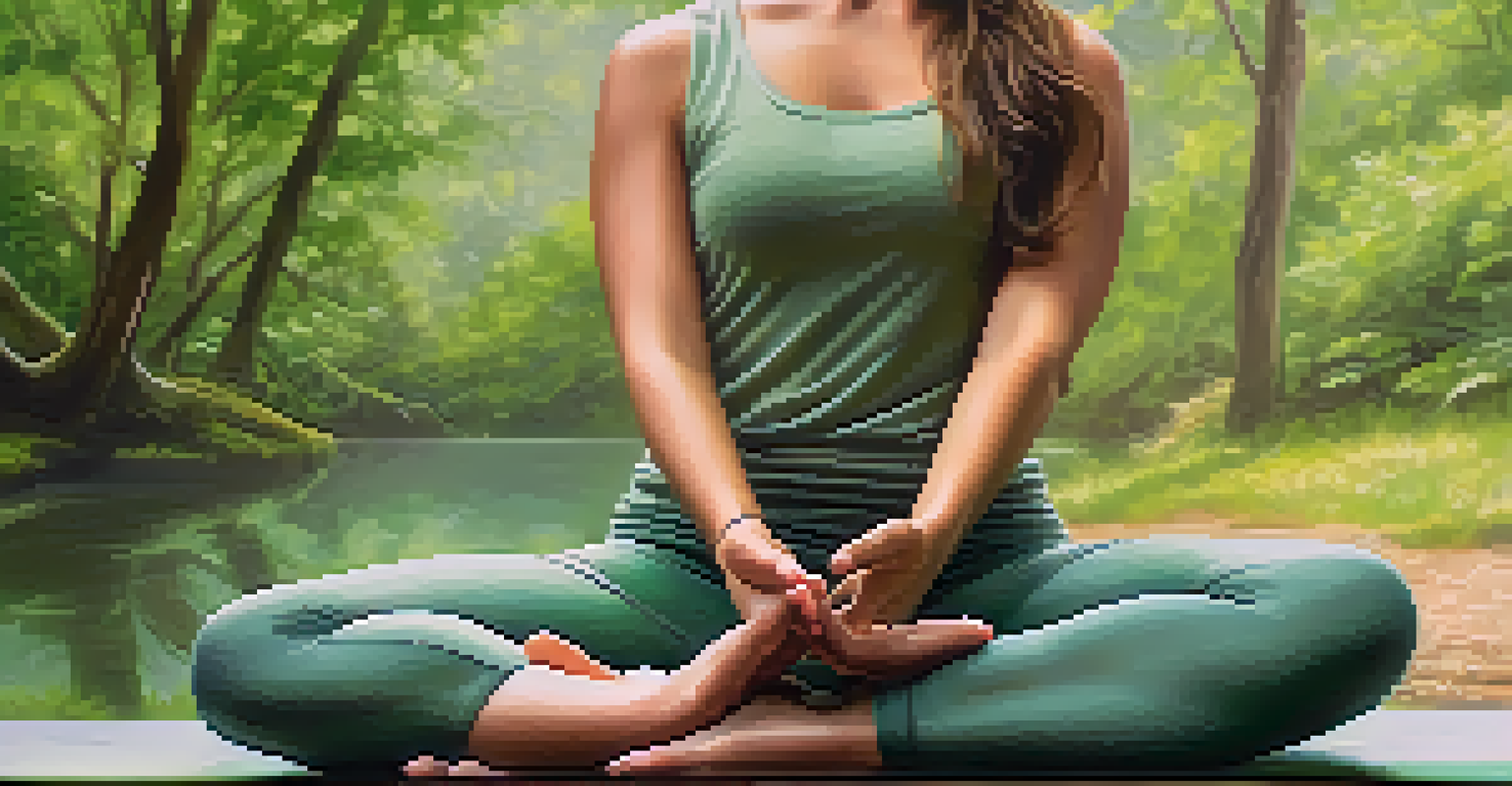Meditative Yoga: Merging Mindfulness with Asanas

What is Meditative Yoga and Why It Matters
Meditative yoga is a beautiful fusion of mindfulness and physical postures, or asanas. This practice encourages a deep connection between the mind and body, allowing individuals to cultivate inner peace and awareness. By integrating mindfulness into yoga, practitioners can enhance their focus and reduce stress levels, making it a powerful tool for mental well-being.
Yoga is the journey of the self, through the self, to the self.
Imagine your mind as a bustling city; meditative yoga acts like a quiet park in the midst of that chaos. It provides a space for you to step back, breathe, and simply be present. This blend of movement and meditation helps to quiet the noise, giving you the clarity to navigate life’s challenges with grace.
Ultimately, meditative yoga is not just about physical flexibility but also about mental resilience. As you engage in this practice, you'll find that it fosters a deeper sense of self-awareness, allowing you to respond to situations with calmness rather than react impulsively.
The Role of Mindfulness in Yoga Practice
Mindfulness is the art of being fully present in the moment, and it plays a crucial role in enhancing your yoga experience. By focusing on your breath and sensations in your body, you cultivate a deeper awareness of your thoughts and feelings. This heightened state of awareness can lead to profound insights about yourself and your surroundings.

Picture mindfulness as a spotlight in a dimly lit room; it illuminates areas of your life that you may have overlooked. When you practice yoga mindfully, you become attuned to your body’s needs, helping to prevent injuries and enhance your overall practice. This intentional focus transforms each pose into a moment of discovery.
Meditative Yoga Enhances Mindfulness
By integrating mindfulness into yoga practice, individuals can cultivate inner peace and improve mental well-being.
Moreover, incorporating mindfulness into your yoga practice can help you build a stronger mind-body connection. This connection is essential for achieving emotional balance, as it encourages you to listen to your body and respond with compassion rather than judgment.
Understanding Asanas: The Physical Component
Asanas are the physical postures in yoga that help to strengthen, stretch, and balance the body. They are not just exercises; when performed mindfully, they become a meditative practice that promotes relaxation and inner peace. Each asana invites you to explore your body’s capabilities and limitations, fostering self-acceptance.
Mindfulness is a way of befriending ourselves and our experience.
Think of asanas like the chapters of a book, each revealing a different aspect of your physical and mental journey. When combined with mindfulness, these postures can help release tension and stress, allowing you to flow more freely through life. The key is to approach each movement with intention and awareness.
In meditative yoga, asanas serve as a bridge between the mind and body, facilitating a holistic approach to wellness. This integration not only improves physical health but also nurtures emotional resilience, making it a valuable practice for anyone seeking balance in their lives.
Breath: The Link Between Mind and Body
Breath is often referred to as the bridge between the mind and body, and in meditative yoga, it takes center stage. Focusing on your breath during asanas helps to synchronize movement and promote a sense of calm. As you inhale deeply and exhale slowly, you create a rhythm that can enhance your overall experience.
Imagine your breath as a gentle wave, flowing in and out with each movement, bringing you deeper into your practice. By connecting your breath with your body’s movements, you cultivate a state of mindfulness that allows you to be fully present. This connection can also help to reduce anxiety and improve concentration.
Breath Connects Mind and Body
Focusing on breath during yoga synchronizes movement and promotes a sense of calm and emotional regulation.
In essence, mastering your breath is like finding the key to unlock a more profound understanding of yourself. It not only supports your physical practice but also serves as a tool for emotional regulation, helping you navigate life’s ups and downs with grace.
Creating a Meditative Yoga Practice at Home
Creating a meditative yoga practice at home can be a rewarding and transformative experience. Start by designating a quiet space where you can practice without distractions; this will help set the tone for mindfulness. A simple mat, some comfortable clothing, and perhaps a few candles or soft music can enhance the ambiance and make your practice more inviting.
Think of your home practice as a sacred ritual, a time to reconnect with yourself amidst the busyness of daily life. Set aside a regular time for your practice, allowing it to become a cherished part of your routine. Consistency is key to deepening your mindfulness and mastering your asanas.
Finally, remember that there is no 'right' way to practice. Listen to your body, adjust your poses as needed, and allow your intuition to guide you. This personalized approach will foster a deeper connection with your practice and encourage continued growth.
The Benefits of Meditative Yoga for Mental Health
Meditative yoga offers a myriad of benefits for mental health, including reduced stress and anxiety levels. By combining mindfulness with physical movement, practitioners can cultivate a sense of calm and clarity, making it an effective tool for managing everyday stressors. Studies have shown that regular practice can lead to improved emotional regulation and resilience.
Imagine meditative yoga as a soothing balm for your mind. Just as a balm soothes a cut, this practice can help heal emotional wounds and promote a greater sense of well-being. By integrating mindfulness into your routine, you're not just improving your physical health but also nurturing your mental state.
Home Practice Offers Personal Growth
Creating a meditative yoga practice at home fosters a deeper connection with oneself and allows for personalized growth.
Furthermore, meditative yoga can enhance your overall perspective on life. When you become more aware of your thoughts and feelings, you gain the ability to respond thoughtfully rather than react impulsively. This shift in mindset can lead to improved relationships, greater satisfaction, and a more fulfilling life.
Tips for Enhancing Your Meditative Yoga Experience
To enhance your meditative yoga experience, consider incorporating a few mindful techniques. Start with setting an intention at the beginning of your practice; this could be a word or phrase that resonates with you. This small yet powerful step can guide your focus and enhance your overall experience.
Additionally, incorporating gentle music or nature sounds can help create a calming atmosphere. This auditory backdrop can assist in grounding your practice and keeping your mind from wandering. Just be sure to choose sounds that are soothing and not distracting.

Lastly, be patient with yourself. Meditation and mindfulness are skills that develop over time, and each practice will be unique. Embrace the journey, celebrate your progress, and allow yourself the grace to grow.